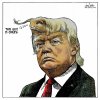Navigation
Install the app
How to install the app on iOS
Follow along with the video below to see how to install our site as a web app on your home screen.
Note: This feature may not be available in some browsers.
More options
Style variation
Guest viewing is limited
- You have a limited number of page views remaining
- 13 guest views remaining
- Register now to remove this limitation
- Already a member? Click here to login
You are using an out of date browser. It may not display this or other websites correctly.
You should upgrade or use an alternative browser.
You should upgrade or use an alternative browser.
Trump Timeline ... Trumpocalypse
- Thread starter CdnGuy
- Start date
But Then It Was Too Late
"What no one seemed to notice," said a colleague of mine, a philologist, "was the ever widening gap, after 1933, between the government and the people. Just think how very wide this gap was to begin with, here in Germany. And it became always wider. You know, it doesn’t make people close to their government to be told that this is a people’s government, a true democracy, or to be enrolled in civilian defense, or even to vote. All this has little, really nothing, to do with knowing one is governing.
"What happened here was the gradual habituation of the people, little by little, to being governed by surprise; to receiving decisions deliberated in secret; to believing that the situation was so complicated that the government had to act on information which the people could not understand, or so dangerous that, even if the people could not understand it, it could not be released because of national security. And their sense of identification with Hitler, their trust in him, made it easier to widen this gap and reassured those who would otherwise have worried about it.
"This separation of government from people, this widening of the gap, took place so gradually and so insensibly, each step disguised (perhaps not even intentionally) as a temporary emergency measure or associated with true patriotic allegiance or with real social purposes. And all the crises and reforms (real reforms, too) so occupied the people that they did not see the slow motion underneath, of the whole process of government growing remoter and remoter.
Last edited:
Ever since Trump won his surprise electoral college victory in November 2016, everyone from pundits to political scientists to average Americans have tried to figure out what went wrong and what to do about it.
The big newspapers wrote an endless series of ethnographic portraits of Trump supporters in small town diners to help their readers understand, but they came off instead as tone deaf. Academics delved deep into the post-election data, making analyses that tried to sound definitive, but often rested on sketchy correlations and questionable assumptions.
And, of course, opinion writers and strategists—like yours truly—made unprovable assertions based on their best reasoned arguments, but ultimately mostly preached to their respective choirs.
It all came down to the right proportion of bigotry versus economic anxiety. When Hillary Clinton made her famous “basket of deplorables” remarks, it is often forgotten that she was actually making the economic anxiety argument: she said that half of Trump’s supporters were bigots, but that the other half “feel that the government has let them down … Those are people we have to understand and empathize with as well.”
Pundits on the progressive and economic-populist left have, ironically enough, long agreed with Clinton about this, arguing that while many or most Trump supporters were inarguably motivated by bigotry, a large chunk were simply votingfor a disrupter to take on a system that had failed them—and, since they weren’t directly threatened themselves by racist policies, figured there was no potential downside to them.
In other words, an electorally significant portion of Trump supporters weren’t voting out of active cruelty. Rather, it was passive indifference to cruelty in the name of thumbing their nose at the system.
But, at a certain point, none of that matters anymore. 2016 is over and done with. Whatever Trump may have represented to a variety of different voters then, and whatever their motivations for casting ballots for him may have been, the person and president Trump is could not be clearer now.
The man is an empathy-free racist who has been credibly accused of sexual misconduct by multiple women. He openly obstructed justice and encouraged a foreign government tampering in the U.S. election on his behalf. No matter how you felt about Hillary Clinton or how you felt about the country back and its relative imbalances of power, none of that matters now.
Similar threads
- Replies
- 20
- Views
- 908
- Replies
- 21
- Views
- 1K
- Replies
- 12
- Views
- 305








